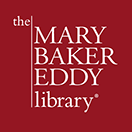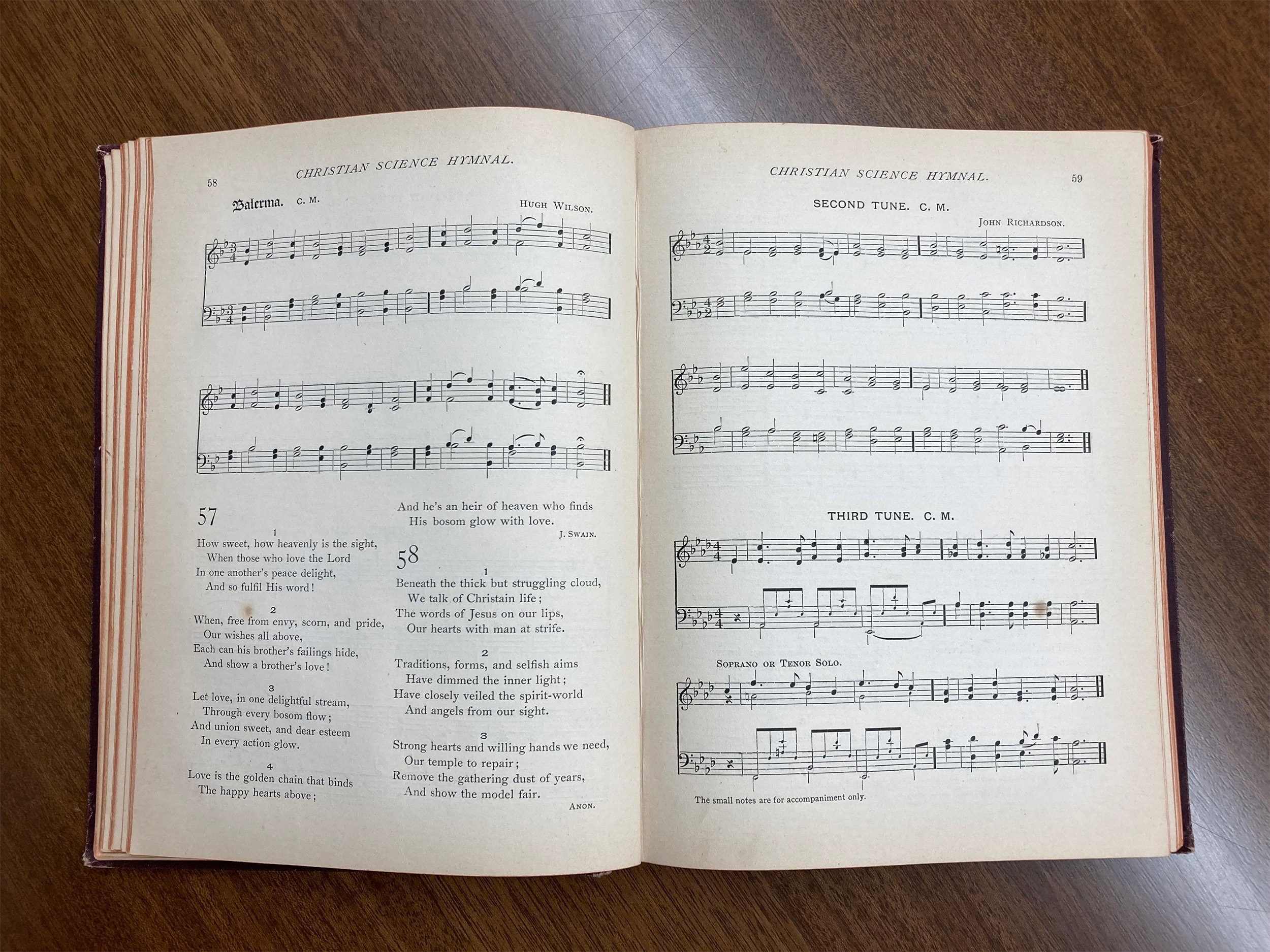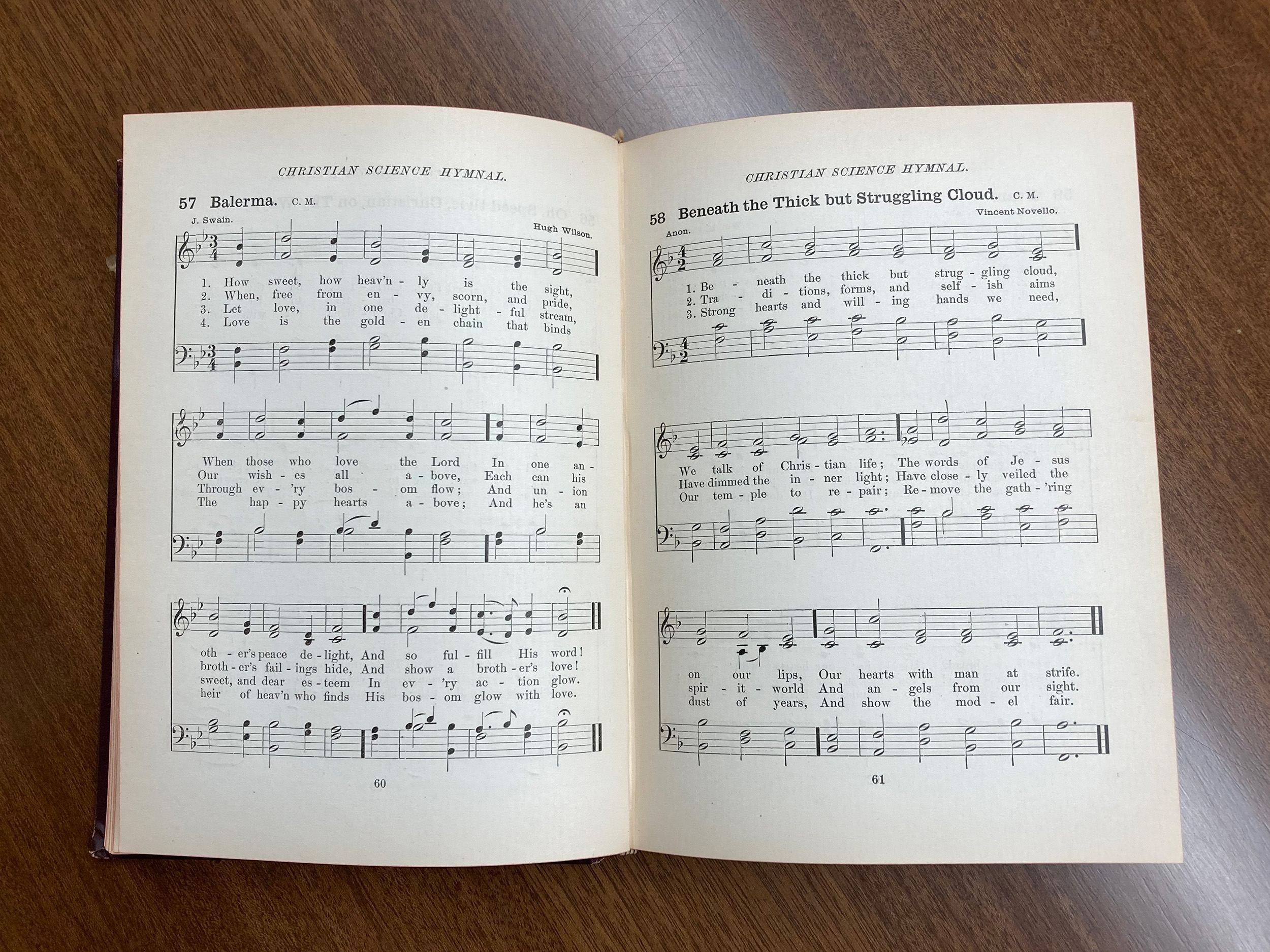The Christian Science Hymnal: History, Heritage, Healing
The Christian Science Hymnal: History, Heritage, Healing
The Christian Science Hymnal: History, Heritage, Healing
Chapter 5
The 1898 and 1910 Hymnal editions
As the nineteenth century drew to a close, the year 1898 marked a number of indications that Christian Science was flourishing. Mary Baker Eddy founded the Christian Science Board of Lectureship and the Christian Science Weekly (later the Christian Science Sentinel). She established The Christian Science Publishing Society and its Bible Lesson committee, taught her last class, and saw the first publication of her poem “Christmas Hymn.”1 Also, the first German Christian Science church was organized in Hannover, Germany.
Another important event took place for the church movement. The 1892 Christian Science Hymnal was updated, in response to requests from Eddy herself, as well as members.

William Lyman Johnson, n.d. P00994A.
The need for revision
In August 1897 Eddy wrote two significant letters concerning the quality of music in the church. The first letter expressed concern that she was not seeing evidence of the spiritual qualities required of the professional musicians performing in the services. She also felt strongly “that congregational singing is the best song service for the Church of Christ, Scientist.”2 Thus in September the Directors voted to retain the role of soloist, but to abolish The Mother Church choir. The congregation would now officially become the “choir” to sing the hymns.3 The second letter had to do with the hymnal revision. According to William Lyman Johnson’s History of the Christian Science Movement, Eddy suggested to the Directors that “should there be at any time a revision of the Hymnal, she would like to have three of her favorite hymns added: ‘I’m a Pilgrim and I’m a Stranger,’ ‘I need Thee every hour,’ and ‘O, the clanging bells of time’.” The first two were incorporated into the revision, but the third was not included until the 1905 printing.4
A revision committee was formed, and Johnson indicated that “it was the aim of the Committee to select for the new hymnal the music which is best known, and the most used.”5 Lyman Brackett probably served as chair. William Lyman Johnson was involved. Albert F. Conant, organist of The Mother Church, and Frederic W. Root (1846–1916), a Christian Scientist and accomplished musician, were also likely part of the team.6
The committee felt that the placement of words and music in the 1892 Hymnal had not proved satisfactory. Many churchgoers had difficulty connecting the words or syllables of the text with their corresponding notes. To help with this, the committee aligned the words directly below the notes to which they were sung—the style familiar in most hymnals today.
Click image to enlarge
Click image to enlarge
Side-by-side images of Hymns 57 and 58 in the 1892 and 1898 Hymnals.
The first printing of the 1898 revision contained 191 hymns, most of them drawn from the 1892 edition. The words to Hymns 1 through 178 remained the same, while many of the less-used alternative tunes were eliminated. Brackett’s melodies continued to be popular—64 were included.
Johnson noted both the positive and negative comments that followed the publication of the 1898 revision:
The result of this first revision, after curiosity and criticism had subsided, was a great and growing increase in the congregational singing. Within a year the newspapers everywhere were noting that the congregations of no other denomination sang so fervently and enthusiastically as those of Christian Science churches.7
Because the movement continued growing, this revised hymnal was printed every year until the publication of the 1910 edition. Each printing had slight changes and contained anywhere from 191 to about 200 hymns.
Eddy communicated regularly with the Directors about hymnal matters. For example, correspondence in 1899 shows edits to the Tate and Brady versification of Psalm 57 for use as a Communion Doxology text. The Directors requested that “the following verse shall be sung in Doxology at the close of the Communion service” and that it be placed at the front of the next printing of the hymnal.8 As a result, the hymn “Be Thou, O God, exalted high” was added as Hymn 1 beginning in 1901, after notable word and punctuation changes:
Tate and Brady:
Be thou, O God, exalted high;
and, as thy glory fills the sky,
So let it be on earth display’d,
Till thou art here, as there, obeyed.
Adapted text:
Be Thou, O God, exalted high;
And as Thy glory fills the sky,
So let it be on earth displayed,
Till Thou art here and now obeyed.
“Be Thou, O God, exalted high” (music from the Genevan Psalter, 1551)
On March 5, 1903, Eddy wrote to the Directors, expressing her desire that they find music for her poem “Christmas Morn.” She wished for “a kind of music that is plaintive and inspiring not noisy but melodious – from the old Masters such as Handel.”9 What they sent Eddy did not satisfy her, so she appealed to Conant to locate music that “moves my heart not head.”10 On November 28, 1903, the Sentinel announced “Mrs. Eddy’s Christmas Hymn,” and the December printing of the Hymnal added two settings—CHRISTMAS MORN, by Conant, and SERENITY, arranged from W. V. Wallace.11
Eddy and Brackett had been friends for a number of years (see chapter 4), and she appreciated his careful professional work in putting together the 1892 edition. However, it is apparent that she tired of his tunes for her poems “Christ My Refuge” and “‘Feed My Sheep’”—in December 1904 she asked Johnson to compose “a proper tune” for them:
The tunes in which I hear those hymns sung continually, no more express my verse than the poor musician’s compositions express your cultured idea of music. Can you, will you compose some music for those hymns that is music in its truest sweetest sense? I will pay you for it so soon as it is accomplished…. O may God guide and bless you in His own way.12
In a 1905 printing, CONCORD—Johnson’s setting of “‘Feed My Sheep’”—was added to the tunes by Brackett, Hoyte, and MacFarren. His PLEASANT STREET setting of “Christ My Refuge” joined three of Brackett’s tunes. In the 1906 printing, Johnson’s two settings remained, while Brackett’s tunes were removed, in addition to those of the other two composers. Brackett was still represented with his tune to “Communion Hymn.” In 1909 Eddy asked Archibald McLellan, a member of the Board of Directors and editor of the religious magazines, to have Brackett’s tunes to “‘Feed My Sheep’” and “Christ My Refuge” restored.13
1910: A new, expanded Hymnal
The young and growing church certainly had reason to be happy with the 1898 edition, with its ongoing additions and improvements. But by 1909 the Directors concluded that the Hymnal needed to be expanded. Six musicians formed the committee that undertook the revision work:
- Frederick W. Root—composer and lyricist, chair
- Albert F. Conant—Mother Church organist, 1897–1898 and 1900–1911
- Helen Allen Hunt—Mother Church soloist
- Walter E. Young—Mother Church organist, 1912–1924
- George E. Hamlin14
- William Lyman Johnson—composer, historian
Click image to enlarge
First Church of Christ, Scientist, Laurel, Mississippi, c. early 1900s. Copies of the Christian Science Hymnal (1892 edition) are stacked in front of the Readers’ table.
No detailed record of this committee’s work exists, so we do not know exactly when the members came together or how often they met. However, on December 4, 1909, the Sentinel announced that “the new and enlarged edition of the Christian Science Hymnal, containing some fifty new hymns, will be ready for delivery about Dec. 20.”15 The revision work was indeed finished and the new volume published that month, known officially as “the 1910 edition.” The preface stated that it was “representative of the best religious and poetic thought in hymnology, including a number of excellent compositions contributed by Christian Scientists.”16
While the most noteworthy feature of the Hymnal’s newest edition was its expansion from approximately 200 to 241 selections, 160 hymns remained unchanged and 40 texts were assigned new tunes. A number of rarely sung tunes were replaced, and others were removed due to copyright complications.
Among the 41 new offerings were well-known, well-loved hymns that would have been familiar to members who had come to Christian Science from other denominations. Here are six examples:17
- “All power is given unto our Lord” (EIN’ FESTE BURG)
- “Fight the good fight with all thy might” (PENTECOST)
- “O God, our help in ages past” (ST. ANNE)
- “O Lord, I would delight in Thee” (ST. LEONARD)
- “Peace be to this congregation” (BEECHER)
- “The heavens declare the glory” (ST. ANSELM)
“O Lord, I would delight in Thee” (words by John Ryland, music by Henry Hiles)
“All power is given unto our Lord” (words by Frederic W. Root, music by Martin Luther)
Eddy’s “Mother’s Evening Prayer,” set to Frederick C. Atkinson’s tune MORECAMBE, became the fifth of her poems to join the Hymnal. David Ogden, Manager of the Publishing Society, wrote Eddy on December 30, 1909:
Beloved Leader:—The copy of the new Hymnal which we are sending you carries with it much love from all the workers in the publishing house.Thank you for the helpful change of words from “far off” to “heavenly” rest in Hymn 197, “The Mother’s Evening Prayer.”
Gratefully and lovingly yours,
David B. Ogden, Manager.18
Just prior to publication, Eddy made “one slight but important change” to “Christ My Refuge.” Verse three of the poem’s earlier version had said, “I kiss the cross, and wait to know / A world more bright.” The revised text was amended to say, “I kiss the cross and wake to know / A world more bright.”19
By 1926 some copies of the 1910 Hymnal included “A COMPLETE CONCORDANCE to the CHRISTIAN SCIENCE HYMNAL.” The creation of this reference was a labor of love undertaken by Ruth E. Smith. The most important feature was an index to the words by hymn number and verse. This was a wonderful new tool that enabled people to reference specific words as they used the Hymnal in their spiritual study.
When Eddy passed away on December 3, 1910, she had established a solid foundation for the Christian Science movement. The enlarged 1910 edition, with texts expressing the metaphysical basis of her discovery, would help to unify and inspire the church for the next 22 years.
“I love to tell the story”
Articles and testimonies
This section chronicles experiences of Christian Scientists who cited hymns from the Christian Science Hymnal, in articles and testimonies published in the Christian Science magazines.
“Step By Step”
Mabel Reed
Christian Science Sentinel, February 17, 1912
“Hymns and Healing”
Vanessa Perry Lobdell
Christian Science Sentinel, July 20, 1918
“Sure Testimony”
Elizabeth C. Adams
Christian Science Sentinel, August 19, 1922
“A well-loved hymn says…”
Joan E. Kirsopp
Christian Science Sentinel, January 3, 1925
“Our Hymnal – An Appreciation”
William R. Rathvon
Christian Science Sentinel, May 3, 1930
“Songs of Christian Scientists”
Francis Lyster Jandron
Christian Science Sentinel, April 18, 1931
Recorded hymns in this chapter are from the Christian Science Hymnal, 1898 and 1910 editions, and performed by Christa Seid-Graham and Denny Veidelis (vocals) and Bryan Ashley (keyboard).
© ℗ 2024 The Mary Baker Eddy Library. All rights reserved.
Chapter notes:
- This was later set to music as “Christmas Morn.” Mary Baker Eddy, “Christmas Hymn,” The Christian Science Journal, December 1898, 587. For more about the development of Christian Science during this period, see the downloadable PDF document “A Chronology of Events Surrounding the Life of Mary Baker Eddy,” available on the Library’s website at Mary Baker Eddy—Deep read.
- Eddy to Mary C. Metcalf and Albert Metcalf, 8 August 1897, L06622B.
- William B. Johnson to Eddy, 13 September 1898, 001dP1.01.016.
- William Lyman Johnson, The History of the Christian Science Movement, Vol. 1 (Brookline, Massachusetts: Zion Research Foundation, 1926), 383.
- Johnson, History of the Christian Science Movement, Vol. 1, 383.
- According to his reminiscence, the Directors selected Johnson to revise this hymnal (181), but a biographical sketch indicates that Brackett was the editor. “Lyman F. Brackett,” February 1962, Subject File.
- Johnson, History of the Christian Science Movement, 384.
- Board of Directors to Eddy, 15 December 1899, L00759. It’s not clear whether Eddy herself revised the Doxology. Her handwriting in the document is only in the punctuation—changes that don’t all appear in the Hymnal’s final version. The revised words may have been a joint effort by Eddy and the Directors.
- Eddy to Board of Directors, 5 March 1903, L02943A.
- Eddy to Albert F. Conant, 10 November 1903, L06851.
- “Mrs. Eddy’s Christmas Hymn,” Christian Science Sentinel, 28 November 1903, 201.
- Eddy to Johnson, 2 December 1904, L03371.
- Eddy to Archibald McLellan, 20 April 1909, L03227.
- Hamlin was a noted American tenor. See “Musical Events in Boston,” The Christian Science Monitor, 10 April 1909, 9.
- “Special Announcements,” Sentinel, 4 December 1909, 278.
- Christian Science Hymnal (Boston: The Christian Science Publishing Society, 1910), iii.
- These entries correspond to the 1932 edition.
- “Letters to our Leader,” Sentinel, 15 January 1910, 392. The last verse of the earlier version had said, “And mother finds her home and far off rest.” Eddy revised this to say, “And mother finds her home and heav’nly rest.”
- Paul O. Williams, “The Evolution of the Christian Science Hymnal” (unpublished manuscript), 1979. Principia College Marshall Brooks Library, Rare Book Collection, BV372. W72 1979, 22.




